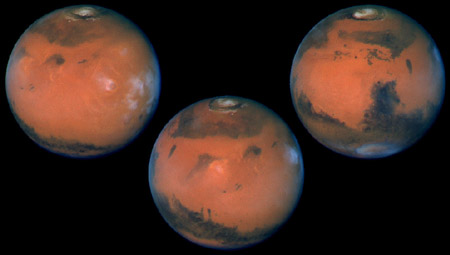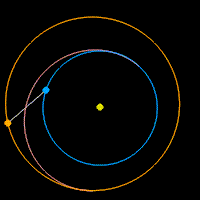Mars: A Century of Exploration
Introductory Slides
[Gustav Holst's Mars: The Bringer of War plays in background.]

Practically everything we know about Mars as a planet, we have learned in
the last 100 years. The ancients knew Mars as
one of the seven objects visible to the naked eye which move
relative to the (apparently) fixed stars (the other six being Mercury,
Venus, Jupiter, Saturn,
the Moon, and the Sun). Mars appears as a deep red "star" to the naked
eye. This blood red color led the ancients to name this wandering star
after the Roman god of war, Mars.
The first in-depth telescopic study of Mars came in the late 1800's. In
1877 the Italian astronomer Giovanni Schiaparelli announced that he had
seen canali (the Italian word for "grooves") on Mars.
 This was
translated into English as "canals" and caught the attention of the New
England aristocrat Percival Lowell.
He established the Lowell Observatory with a 24 inch
refracting telescope in Flagstaff, Arizona specifically for the study
of Mars.
This was
translated into English as "canals" and caught the attention of the New
England aristocrat Percival Lowell.
He established the Lowell Observatory with a 24 inch
refracting telescope in Flagstaff, Arizona specifically for the study
of Mars.
 Lowell studied Mars for over
a decade. During this time, he developed maps of Mars with great networks
of canals. Unfortunately, the existence of these canals seem to have been
more in Lowell's mind than in reality. More detailed studies revealed no
such collection of canals.
Lowell studied Mars for over
a decade. During this time, he developed maps of Mars with great networks
of canals. Unfortunately, the existence of these canals seem to have been
more in Lowell's mind than in reality. More detailed studies revealed no
such collection of canals.
Telescopic studies of Mars continue even today.
 Unfortunately, the motions
of the Earth and Mars around the Sun are such that Mars is close to Earth
only once every two years or so. Here we see the orbits of Earth (inner
circle) and Mars (outer circle). The arc represents the path of the Mars
Global Surveyor, a recent successful probe to Mars.
Unfortunately, the motions
of the Earth and Mars around the Sun are such that Mars is close to Earth
only once every two years or so. Here we see the orbits of Earth (inner
circle) and Mars (outer circle). The arc represents the path of the Mars
Global Surveyor, a recent successful probe to Mars.
Go to
next section.















